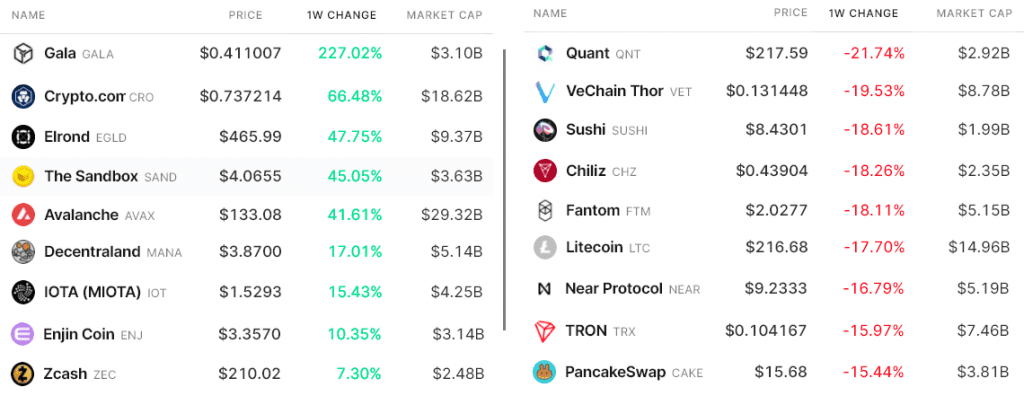Looking at the past 7-days of winners and losers might give one the impression that cryptocurrency markets are net positive. Still, total market capitalization actually fell by 6.7% to $2.72 trillion as Bitcoin’s (BTC) price retraced 8.3% to $58,425.
The only connection between this week’s top gainers seems to be the Metaverse and gaming sector, which has been on a bull run since Facebook rebranded to Meta on Oct. 28, signaling its new focus on that segment. Further bullish news backing the current surge in Metaverse-related tokens is Gemini exchange raising $400 million on Nov. 19 to build a decentralized Metaverse.
Top performers had specific reasons for the pumping
Gala (GALA) pumped after its Coinbase and Huobi listing on Nov. 16. The utility token powers a decentralized gaming ecosystem that gives players a voice in the funding and development phases.
Crypto.com (CRO) also had news of its own on Nov. 18 to justify the rally. The marketing department behind the Singapore-based exchange decided to splurge $700 million to purchase the naming rights to the stadium where the NBA’s Los Angeles Lakers play.
On Nov. 19, Elrond (EGLD) also announced a $1.29 billion incentive program to help attract users and liquidity to its decentralized finance ecosystem. The project uses sharding technology to achieve up to 15,000 transactions per second (TPS).
Decentralized exchanges tokens take a hit
Among the worst performers, there were two decentralized exchange utility tokens. The only negative news appeared to be the Nov. 9 paper by the United States Securities and Exchange Commission Commissioner Caroline Crenshaw. The study mentioned that the sector lacks market protections and raises concerns about pseudonymity and market manipulation.
Quant (QNT) continues in a downtrend after a 122% 7-day rally on Sept. 3, fueled by a protocol upgrade that allowed ERC-20 and ERC-721 token interoperability.
Vechain Thor (VET) retraced after a 38% 7-day pump on Nov. 2 ahead of its proof-of-authority (PoA) mechanism v2.0 testnet release on Nov. 5. The upgrade offers a more secure system to select the block producers.
The OKEx Tether (USDT) premium, which measures the difference between its China-based peer-to-peer (p2p) trades versus the official U.S. dollar currency, has slightly improved.

The current 99% indicator is slightly bearish, and it signals weak demand from cryptocurrency traders to convert cash into stablecoins—still a vast improvement from the 5% discount in mid-Oct.
Meanwhile, the cryptocurrency total futures open interest was negatively impacted by the generalized price drop. Nevertheless, the move was expected since the total market cap retraced and some $2.7 billion worth of liquidations took place during the week.

Despite this, the indicator remained at a healthy $50.3 billion mark, which is 60% higher than two months ago. It is worth noting that an open interest decrease is not necessarily bearish, but maintaining a certain level is interesting as more liquidity providers and market makers enter the market.
The above data might not sound encouraging, but considering that Bitcoin (BTC) and Ether (ETH) suffered considerable losses this week, the overall market structure held nicely. Those betting on an “altcoin season” may have been disappointed, but at least there were no generalized 15% or higher losses.
The views and opinions expressed here are solely those of the author and do not necessarily reflect the views of Cointelegraph. Every investment and trading move involves risk. You should conduct your own research when making a decision.


